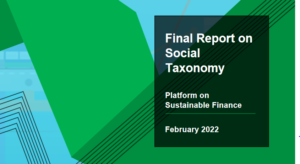Can companies quantify their own ESG impact on the environment and society? Two major pharmaceutical companies say yes – and could point the way to an even more complex ESG accounting future.
It is easy to lose track of all the units out there in the ESG ecosystem: t CO2e / k €. MWh / t. kt NMVOC. ISO 50001:2018 (in %). LTIFR. OIFR. STI in %.
If you were able to correctly assign all of these units to an ESG indicator: Congratulations. But don’t cheer too soon, because the flood of ESG indicators has not yet come to an end. One reason for that: several major players are preparing to add a whole new dimension to their ESG reporting: with the help of the so-called “sustainability accounting”. Its supporters are hiding behind lofty associations such as the „Impact-Weighted-Accounts Project“ or the „Value Balancing Alliance“ – and the pharmaceutical companies Novartis and Merck are right at the forefront of the movement.
What does (saving) the world cost?
 What’s behind the idea of sustainability accounting? In a nutshell: the effort to break down a company’s overall impact on the environment and society into easily digestible monetary amounts.
What’s behind the idea of sustainability accounting? In a nutshell: the effort to break down a company’s overall impact on the environment and society into easily digestible monetary amounts.
Companies from German-speaking countries are spearheading this movement. Currently, six DAX companies are already calculating their environmental and social impact on the planet using the methodology of the Value Balancing Alliance.
From Switzerland, the pharmaceutical giant Novartis is one of them. And the „bottom line“ that the company calculates for itself seems quite impressive: although Novartis says that the company attributes to an overall negative environmental impact of USD 7.7 billion for 2020, this number pales in comparison with a positive social impact of its products of a whopping USD 242 billion.
ESG innovations driving the pharmaceutical industry
It is unclear how reliable such calculations are – the calculation methods are complex and, with so few users so far, hardly comparable in a serious way. And for the vast majority of investors or ESG rating agencies, sustainability accounting does not yet play a significant role in their ESG assessment of companies.
However, the Value Balancing Alliance is backed by the major auditors of the “Big Four”. It is therefore not completely inconceivable that sustainability accounting could play an even greater role when it comes to future regulations.
The German pharmaceutical company Merck KGaA has even gone one step further and developed its own ESG impact calculation unit: the „sustainable business value“ (SBV), with which the company makes internal calculations as to what positive (or negative) impacts a new product would have on the environment and/or society. Merck, for example, has developed a liquid crystal glass for windows whose capabilities can – according to the company – improve the indoor climate to such an degree that employees are said to work four days “faster” per year than with windows with blinds and are sick one day less.
The fundamental ESG topics for pharmaceutical companies
 But even beyond such ESG experiments as those of Novartis or Merck, the challenges for pharmaceutical companies should not be underestimated: the requirements are already high for the “usual” ESG indicators.
But even beyond such ESG experiments as those of Novartis or Merck, the challenges for pharmaceutical companies should not be underestimated: the requirements are already high for the “usual” ESG indicators.
The focus is on the social area of the three ESG dimensions, while environmental issues play only a comparatively minor role for pharmaceutical companies. The SASB standards, for example, which most ESG rating agencies follow, do not define a single environmental area as particularly important for pharmaceutical companies, and just one governance issue category: “Business ethics.”
In contrast, SASB identifies no less than 7 relevant topic areas from the social sphere:
- Human rights and community relations
- Access and affordability
- Product quality and safety
- Patient well-being
- Sales practices and product labeling
- Employee engagement, diversity and inclusion
- Supply chain management
However, with this wide range of social issues, the fit for pharmaceutical companies is not always straightforward …
What are the difficulties for pharmaceutical companies?
 One of the difficulties for investors and rating analysts in obtaining an accurate picture of the ESG performance of a pharmaceutical company is that their business models are often different. Company A may be a large pharmaceutical company that conducts its own intensive research and is active worldwide – and Company B may primarily hold only marketing rights to drugs, thus not conducting its own research, while production and sales are largely outsourced.
One of the difficulties for investors and rating analysts in obtaining an accurate picture of the ESG performance of a pharmaceutical company is that their business models are often different. Company A may be a large pharmaceutical company that conducts its own intensive research and is active worldwide – and Company B may primarily hold only marketing rights to drugs, thus not conducting its own research, while production and sales are largely outsourced.
Both companies face different challenges – but are rated by ESG rating agencies according to the same scheme. As a result, rating agencies often miss the mark on a company’s truly relevant ESG issues. The result: unjustifiably poor ESG ratings.
The only thing that affected companies can do is to present their ESG focal points in a comprehensible way, in line with their business model. One way to do this is to conduct an ESG materiality analysis to strengthen their own argumentation and strategy. And the next step is to go into the direct exchange with rating agencies and investors so that their ESG criteria can be better adjusted for the company.
Looking into the future: the EU social taxonomy
 In terms of future requirements, many companies are currently focusing on the EU taxonomy. In its current form, however, it has only a limited impact on the pharmaceutical industry. The simple reason is that it does not (yet) contain any applicable sustainability provisions for the business activities of pharmaceutical companies. For this reason, pharmaceutical companies are initially “only” required to break down OpEx and CapEx according to the criteria of the EU taxonomy: for example, if they invest in the generation of their own renewable energies.
In terms of future requirements, many companies are currently focusing on the EU taxonomy. In its current form, however, it has only a limited impact on the pharmaceutical industry. The simple reason is that it does not (yet) contain any applicable sustainability provisions for the business activities of pharmaceutical companies. For this reason, pharmaceutical companies are initially “only” required to break down OpEx and CapEx according to the criteria of the EU taxonomy: for example, if they invest in the generation of their own renewable energies.
There is more potential in another future EU project: the so-called “Social Taxonomy”. Even though it will still take probably several more years before it is adopted, its provisions are likely to be of particular interest to the pharmaceutical industry, as it explicitly covers the area of “access to healthcare”. This is already evident in the EU’s first draft, which was published in early 2022: on p. 58, early adopters can already find the first rough planned criteria for the pharmaceutical industry.
Do you need support to go head-to-head with investors or rating agencies regarding their ESG criteria? Or do you just want to learn a bit more about sustainable accounting or social taxonomy? Either way: get in touch!




